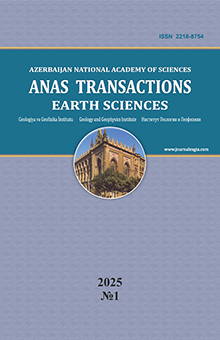Igneous and sedimentary volcanic systems: comparative analysis of the isotopic composition of gases
Feyzullayev A.A.
Ministry of Science and Education of the Republic of Azerbaijan, Institute of Geology and Geophysics: fakper@gmail.com
Summary
The purpose of the study was to assess the nature of the gases of various volcanic systems using known genetic criteria developed by many years of research by a number of scientists around the world. A comprehensive processed and analyses of the collected large amount of literature data and the author's own research results made the following main conclusions:
– the isotope composition (IC) of CO2 and argon (40Ar/36Ar) in igneous volcanoes varies within very narrow limits, in comparison with sedimentary volcanoes. However, the use of these parameters as an unambiguous genetic criterion is not possible;
– more objective genetic indicators are: helium isotope ratio (R/Ra) and IC of hydrocarbon (HC) gases. According to these parameters, the HC gases of the considered volcanic systems have different genetic sources: a) abiogenic in igneous and carbonic sedimentary volcanic systems; b) predominantly abiogenic-biogenic - in the hydrothermal system; c) biogenic - in methane sedimentary volcanoes;
– amount of abiogenic methane in the gas of the igneous volcanic system is about 1% on average.
The results are of interest in connection with the discussion about the genesis of commercial accumulations of HCs in the sedimentary strata of the earth's crust.
Keywords: igneous / hydrothermal and sedimentary volcanic systems, gas, isotopic composition, comparative genetic analysis
ЛИТЕРАТУРА
Anderson D.L. The statistics and distribution of helium in the mantle. Int. Geology Rev., 42, 2000, pp. 289-311.
Dai J., Caineng, Zou, Shuichang, Zhang et al. Discrimination of abiogenic and biogenic alkane gases. Sci. China Earth Sci., Vol. 51 (12), 2008, pp. 1737-1749.
Dimitrov L.I. Mud volcanoes - the most important pathway for degassing deeply buried sediments. Earth-Sci. Rev., Vol. 59, 2002, pp. 49-76.
Guliyev I.S., Feizullayev A.A. All about Mud Volcanoes. Nafta Press. Baku, Azerbaijan, 1997, 52 pp.
Isotope Geochemistry (Second Edition). Chapter 12. Noble Gas Geochemistry, 2014, pp. 427-460.
Jackson R.B., Saunois M., Bousquet P. et al. Increasing anthropogenic methane emissions arise equally from agricultural and fossil fuel sources. Environ. Res. Lett., Vol. 15(7), 2020, pp. 1-7.
Joseph E.P., Fournier N., Lindsay J.M., Fischer T.P. Gas and water geochemistry of geothermal systems in Dominica, Lesser Antilles island arc. Journal of Volcanology and Geothermal Research, Vol. 206, 2011, pp. 1-14.
Kopf A.J. Significance of mud volcanism. Rev. Geophys., Vol. 40, 2002, 1-51.
Le Pichon X., Foucher J.P., Boulègue J. et al. Mud volcano field seaward of the Barbados accretionary complex: A submersible survey. J. Geophys. Res. Solid Earth, Vol. 95 (B6), 1990, pp. 8931-8943.
Lorenson T.D., Kvenvolden K.A. A comparison of hydrocarbon gases from natural sources in the Northwestern United States. In: Howell, D.G. (Ed.) The Future of Energy Gases. U.S. Geological Survey Professional Paper, 1570, 1993, pp. 453-470.
Menapace W. Mud volcanic episodicity: Subduction zone water budget, long-term monitoring and laboratory case studies. Dissertation. Universität Bremen. 2017.
Prinzhofer A. Noble Gases in Oil and Gas Accumulations. In: Burnard, P. (eds) The Noble Gases as Geochemical Tracers. Advances in Isotope Geochemistry. Springer. Berlin, Heidelberg. 2013, pp. 225-247.
DOI: 10.33677/ggianasconf20230300031
